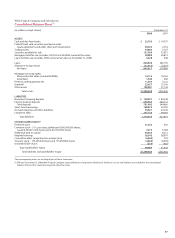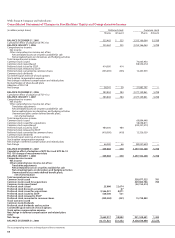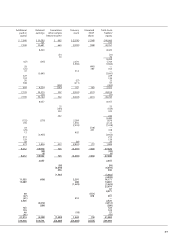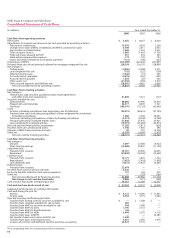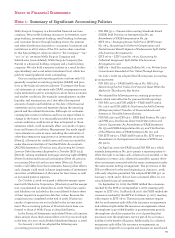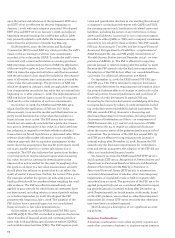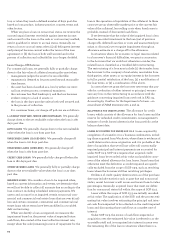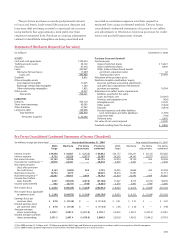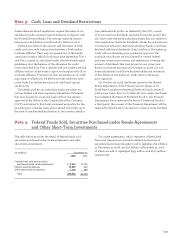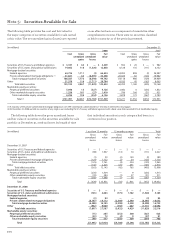Wells Fargo 2008 Annual Report Download - page 97
Download and view the complete annual report
Please find page 97 of the 2008 Wells Fargo annual report below. You can navigate through the pages in the report by either clicking on the pages listed below, or by using the keyword search tool below to find specific information within the annual report.
sale as whole loans. Effective January 1, 2007, in connection
with the adoption of FAS 159, The Fair Value Option for
Financial Assets and Financial Liabilities, including an amend-
ment of FASB Statement No. 115 (FAS 159), we elected to mea-
sure new prime residential MHFS at fair value (see Note 17).
Nonprime residential and commercial MHFS continue to
be held at the lower of cost or market value. For these loans,
gains and losses on loan sales (sales proceeds minus carrying
value) are recorded in noninterest income. Direct loan origi-
nation costs and fees are deferred at origination of the loans
and are recognized in mortgage banking noninterest income
upon sale of the loan.
Our lines of business are authorized to originate held-for-
investment loans that meet or exceed established loan prod-
uct profitability criteria, including minimum positive net
interest margin spreads in excess of funding costs. When a
determination is made at the time of commitment to originate
loans as held for investment, it is our intent to hold these
loans to maturity or for the “foreseeable future,” subject to
periodic review under our corporate asset/liability manage-
ment process. In determining the “foreseeable future” for
these loans, management considers (1) the current economic
environment and market conditions, (2) our business strategy
and current business plans, (3) the nature and type of the loan
receivable, including its expected life, and (4) our current
financial condition and liquidity demands. Consistent with
our core banking business of managing the spread between
the yield on our assets and the cost of our funds, loans are
periodically reevaluated to determine if our minimum net
interest margin spreads continue to meet our profitability
objectives. If subsequent changes in interest rates significant-
ly impact the ongoing profitability of certain loan products,
we may subsequently change our intent to hold these loans
and we would take actions to sell such loans in response to the
Corporate ALCO directives to reposition our balance sheet
because of the changes in interest rates. Such Corporate
ALCO directives identify both the type of loans (for example
3/1, 5/1, 10/1 and relationship adjustable-rate mortgages
(ARMs), as well as specific fixed-rate loans) to be sold and the
weighted-average coupon rate of such loans no longer meet-
ing our ongoing investment criteria. Upon the issuance of
such directives, we immediately transfer these loans to the
MHFS portfolio at the lower of cost or market value.
Loans Held for Sale
Loans held for sale are carried at the lower of cost or market
value (LOCOM) or fair value under FAS 159. For loans
carried at LOCOM, gains and losses on loan sales (sales
proceeds minus carrying value) are recorded in noninterest
income, and direct loan origination costs and fees are
deferred at origination of the loan and are recognized in
noninterest income upon sale of the loan.
Loans
Loans are reported at their outstanding principal balances net
of any unearned income, charge-offs, unamortized deferred
fees and costs on originated loans and premiums or discounts
on purchased loans, except for certain purchased loans that
fall under the scope of SOP 03-3, which are recorded at fair
value on their purchase date. See “Loans accounted for under
SOP 03-3” on page 96. Unearned income, deferred fees and
costs, and discounts and premiums are amortized to income
over the contractual life of the loan using the interest method.
We offer a portfolio product known as relationship
adjustable-rate mortgages (ARMs) that provides interest rate
reductions to reward eligible banking customers who have an
existing relationship or establish a new relationship with
Wells Fargo. Accordingly, this product offering is generally
underwritten to certain Company guidelines rather than
secondary market standards and is typically originated for
investment. At December 31, 2008 and 2007, we had $15.6 bil-
lion and $15.4 billion, respectively, of relationship ARMs in
loans held for investment. Originations, net of collections and
proceeds from the sale of these loans are reflected as invest-
ing cash flows consistent with their original classification.
Loans also include direct financing leases that are recorded
at the aggregate of minimum lease payments receivable plus
the estimated residual value of the leased property, less
unearned income. Leveraged leases, which are a form of
direct financing leases, are recorded net of related nonre-
course debt. Leasing income is recognized as a constant per-
centage of outstanding lease financing balances over the
lease terms.
Loan commitment fees are generally deferred and amor-
tized into noninterest income on a straight-line basis over the
commitment period.
We pledge loans to secure borrowings from the Federal
Home Loan Bank and the Federal Reserve Bank as part of our
liquidity management strategy. At December 31, 2008, loans
pledged where the secured party has the right to sell or
repledge totaled $201 billion, and loans pledged where the
secured party does not have the right to sell or repledge
totaled $137 billion.
NONACCRUAL LOANS We generally place loans on nonaccrual
status when:
• the full and timely collection of interest or principal
becomes uncertain;
• they are 90 days (120 days with respect to real estate 1-4
family first and junior lien mortgages and auto loans) past
due for interest or principal (unless both well-secured and
in the process of collection); or
• part of the principal balance has been charged off.
Loans subject to SOP 03-3 are written down to an amount
estimated to be collectible. Accordingly, such loans are no
longer classified as nonaccrual even though they may be con-
tractually past due, because we expect to fully collect the new
carrying values of such loans (that is, the new cost basis aris-
ing out of purchase accounting).
Generally, consumer loans not secured by real estate or
autos are placed on nonaccrual status only when part of the
principal has been charged off. These loans are charged off or
charged down to the net realizable value of the collateral
when deemed uncollectible, due to bankruptcy or other fac-




